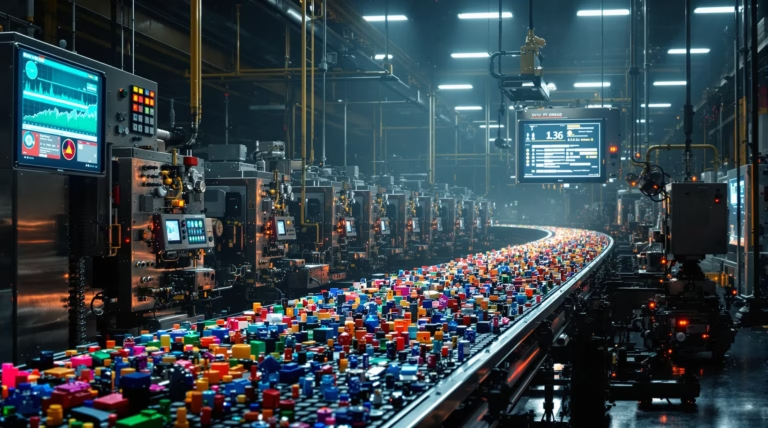Toyota Production System: Principles and Benefits Explained
The Toyota Production System (TPS) has revolutionized global manufacturing practices, setting new standards for efficiency and quality. This comprehensive guide explores how TPS transformed from a post-war necessity into a worldwide benchmark for manufacturing excellence.
The Toyota Production System represents a revolutionary approach to manufacturing that has fundamentally changed how companies worldwide approach production. Created by Toyota Motor Company, TPS focuses on eliminating waste, optimizing efficiency, and maintaining consistent quality standards. This methodology has become the cornerstone of lean manufacturing principles, extending far beyond automotive production.
TPS embodies a philosophy where waste reduction leads to value maximization. Instead of merely increasing production speeds or reducing costs, the system takes a holistic view of manufacturing, identifying and eliminating non-value-adding activities. This systematic approach has enabled Toyota to maintain exceptional quality while achieving remarkable operational efficiency.
The Origins and Evolution of TPS
In post-World War II Japan, amid severe resource constraints and economic challenges, Toyota executive Taiichi Ohno began developing innovative manufacturing approaches. While studying American production methods, particularly Ford’s mass production techniques, Ohno adapted these approaches to suit Toyota’s unique circumstances and limitations.
Through continuous refinement, what started as a response to material shortages evolved into a sophisticated production philosophy. The 1970s oil crisis highlighted Toyota’s remarkable resilience, sparking global interest in the system. As TPS principles spread worldwide under the name ‘lean manufacturing,’ they maintained Ohno’s core vision: creating more value with fewer resources through systematic waste elimination.
Core Principles of the Toyota Production System
- Just-in-Time (JIT) Production – ensures components arrive exactly when needed, reducing inventory costs and storage requirements
- Jidoka – implements automation with human intelligence, allowing workers to stop production when detecting abnormalities
- Continuous Improvement (Kaizen) – encourages worker participation in process enhancement and waste elimination
- Quality Integration – builds quality checks into each production step
- Worker Empowerment – gives employees authority to maintain quality standards
Key Concepts of the Toyota Production System
The Toyota Production System integrates several foundational concepts into a comprehensive management philosophy. This approach optimizes the entire manufacturing ecosystem, including supplier and customer relationships, while focusing on waste elimination and efficiency improvement.
Understanding Jidoka: Automation with a Human Touch
Jidoka represents the innovative integration of human intelligence with automated processes. Unlike conventional automation, Jidoka empowers both machines and workers to detect abnormalities and halt production when issues arise. This system includes the famous andon cord system, allowing workers to stop the production line until problems are resolved, ensuring quality at every step.
Just-in-Time: Efficiency and Waste Reduction
| JIT Component | Benefit |
|---|---|
| Precise Material Timing | Reduces inventory costs and storage requirements |
| Demand-Based Production | Eliminates excess inventory and waste |
| Quick Problem Identification | Reveals bottlenecks and quality issues immediately |
| Flexible Manufacturing | Enables rapid adaptation to market changes |
The Role of Kanban in TPS
Kanban functions as the vital communication system enabling Just-in-Time production within the Toyota Production System. Translating from Japanese as “signboard” or “billboard,” these visual signals orchestrate the flow of production and materials throughout the manufacturing process. While traditionally implemented through cards, modern kanban systems may utilize electronic signals, empty containers, or other visual indicators to trigger production only when downstream processes require it.
This sophisticated scheduling system creates a self-regulating workflow that prevents overproduction – considered the most detrimental form of waste in TPS. The process works through a simple yet effective mechanism:
- When a workstation depletes parts from a container, the kanban card returns to the previous station
- This card authorizes production of the exact quantity needed for replacement
- Each process produces only what the next process requires, precisely when needed
- Work-in-progress remains limited through clear visual signals
- Early warning systems identify production issues before they become critical problems
Benefits of Implementing the Toyota Production System
The Toyota Production System delivers transformative advantages through its focus on eliminating three critical inefficiencies:
- Waste (muda) – removing non-value-adding activities
- Inconsistency (mura) – smoothing out process variations
- Overburden (muri) – preventing excessive strain on resources
These improvements extend beyond manufacturing efficiency, creating positive impacts throughout organizations from production floors to executive decision-making. The system’s universal principles have proven effective across diverse sectors, including healthcare, software development, and service industries, demonstrating its adaptability beyond automotive manufacturing.
Enhancing Productivity and Reducing Costs
| Improvement Area | Benefits |
|---|---|
| Workflow Optimization | Decreased cycle times, increased throughput |
| Waste Elimination | Lower capital investment, reduced operating expenses |
| Inventory Management | Decreased carrying costs, minimal storage requirements |
| Quality Control | Reduced rework and warranty costs |
Maintaining High Quality Standards
Quality excellence emerges through the jidoka principle, integrating quality checks at every production stage rather than just the end. This built-in approach prevents defective components from progressing through the system, significantly reducing customer-facing defects. Automated quality control systems work in harmony with human oversight, while visual management techniques make abnormalities immediately apparent.
The quality benefits extend to the entire customer experience, aligning quality efforts with end-user values. This creates more reliable and consistent production processes, fostering greater customer satisfaction and loyalty. The embedded continuous improvement mindset drives organizations to constantly pursue perfection, distinguishing TPS practitioners in competitive markets.
Promoting Employee Engagement and Development
- Empowerment to stop production when quality issues arise
- Active participation in kaizen improvement activities
- Ownership of work areas and processes
- Cross-training opportunities across different positions
- Development of technical and analytical skills
- Leadership support through coaching rather than controlling
This investment in human capital not only enhances current operations but builds organizational capability supporting long-term competitiveness and market adaptation. The system creates a more meaningful work experience, leading to higher job satisfaction and reduced turnover while developing deep process knowledge throughout the organization.
Challenges and Critiques of the Toyota Production System
The Toyota Production System (TPS), despite its global recognition and manufacturing impact, faces several significant implementation challenges. While its methodology has revolutionized production processes worldwide, organizations often discover that successful TPS adoption requires more than merely copying Toyota’s tools – it demands a complete transformation of organizational culture and mindset.
- Stability concerns in volatile markets
- Vulnerability during supply chain disruptions
- Difficulty maintaining lean inventory levels
- Challenge of sustaining long-term initiatives
- Conflict between methodical improvement and quick results
Misapplication of Just-in-Time
| Common JIT Implementation Errors | Required Foundation Elements |
|---|---|
| Focus solely on inventory reduction | Strong supplier relationships |
| Insufficient process reliability | Robust quality control systems |
| Inadequate risk assessment | Balanced inventory safeguards |
| Limited supply chain resilience | Comprehensive risk management |
The COVID-19 pandemic particularly exposed vulnerabilities in extreme lean practices, demonstrating how some organizations sacrificed operational resilience for efficiency. However, these challenges often stem from misinterpretation rather than inherent system flaws, as Toyota’s original vision emphasizes balanced efficiency with appropriate risk management.
Cultural Differences in Implementation
Cultural factors create significant implementation barriers across different global contexts. The system’s Japanese cultural foundations – including collectivist values, hierarchical respect, and commitment to continuous improvement – don’t always align with other societal norms.
- Public problem highlighting conflicts with face-saving cultures
- Collaborative approaches clash with authoritarian management styles
- Different work-life balance perspectives affect improvement activities
- Varying leadership styles impact communication and enforcement
- Cultural adaptation requires extensive training investment
Conclusion: The Future of the Toyota Production System
TPS continues evolving while maintaining its fundamental principles of waste elimination, continuous improvement, and human respect. The integration of Industry 4.0 technologies has created ‘TPS 4.0,’ combining traditional methodologies with artificial intelligence, IoT sensors, and advanced analytics. Toyota’s introduction of the Toyota New Global Architecture (TNGA) demonstrates the system’s ongoing relevance and adaptability.
Adapting TPS for Sustainability Challenges
- Carbon footprint reduction initiatives
- Resource consumption minimization
- Circular economy practice development
- Energy usage optimization
- Transportation emissions reduction
- Environmental Challenge 2050 goals integration
The system’s waste elimination mindset naturally aligns with environmental sustainability goals, proving that TPS principles can effectively address modern challenges while maintaining operational excellence. This adaptability reinforces TPS’s position as a dynamic, evolving methodology rather than a fixed set of tools.
The Global Impact and Continuing Innovation
The Toyota Production System’s influence has transcended manufacturing boundaries, making significant impacts across diverse sectors. The system’s adaptability has proven particularly valuable in:
- Healthcare – reducing patient wait times and enhancing care quality
- Software Development – transforming visual management into agile methodologies
- Construction – streamlining project management and resource allocation
- Government Services – improving operational efficiency and service delivery
- Education – optimizing administrative processes and resource management
| Industry | TPS Innovation Application |
|---|---|
| Healthcare | Patient flow optimization, inventory management, error reduction |
| Software | Agile development, sprint planning, continuous deployment |
| Construction | Lean construction methods, waste reduction, project scheduling |
| Government | Process standardization, service efficiency, resource optimization |
Looking ahead, TPS continues to evolve while maintaining its philosophical foundation. In an increasingly automated world, the system’s emphasis on human development becomes more crucial than ever. Organizations that successfully balance technological advancement with TPS’s human-centered approach are positioned to achieve sustainable competitive advantages. The system’s enduring strength lies not in rigid tool adherence but in its universal principles that promote thoughtful problem-solving and respect for human potential.







